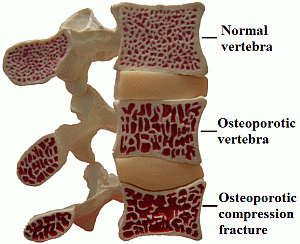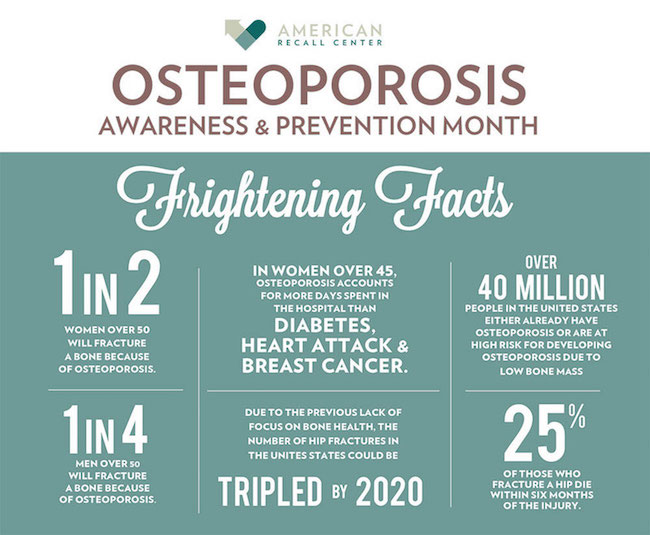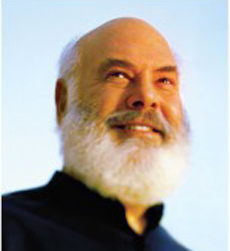Osteoporosis is a somewhat treatable condition in which the bones become brittle and weak, is responsible for about 70% of the hip fractures in Canada, leading to considerable disability. Healthy lifestyle choices begun at an early age combined with proper screening, early detection, and appropriate Osteoporosis treatment can offset bone loss and prevent or delay serious complications.
Throughout our lives our bodies go through a process of breaking down old bone material and replacing it with new bone. In our early years, we make more bone than we lose until we reach our lifetime maximum bone mass. For a woman that can happen in her teen years. For men, it’s a little later. At that point, the process reaches a balance and the amount of bone made is about the same as the amount of bone lost. As we age, we begin to lose bone faster than we make it.
One in four Canadian women and one in eight men over the age of 50 will lose so much of their bone mass that their bones will become fragile and break easily. In severe cases, a simple hug can be enough to break a bone. It is important to know the risk factors for Osteoporosis as well as Osteoporosis treatment if you have it now.
Who is likely to develop Osteoporosis?
 A number of factors appear to play a role in determining who will develop the condition. The Osteoporosis Society of Canada has identified major and minor risk factors. The more of these risk factors you have, the greater your chance of developing osteoporosis.
A number of factors appear to play a role in determining who will develop the condition. The Osteoporosis Society of Canada has identified major and minor risk factors. The more of these risk factors you have, the greater your chance of developing osteoporosis.
The major risk factors for Osteoporosis are:
- Fracture with minimal trauma after age 40
- Family history of osteoporotic fracture (especially if your mother had a hip fracture)
- Long-term (over three months) therapy with a glucocorticoid (a group of anti-inflammatory drugs used to treat conditions such as rheumatoid arthritis)
- Having a medical condition that affects the absorption of nutrients (such as celiac disease or Crohn’s disease)
- Primary hyperparathyroidism (overproduction of parathyroid hormone)
- Tendency to fall
- Osteopenia (decreased bone density but not enough to be classified as osteoporosis) apparent on x-ray
- Hypogonadism (low – testosterone in men or loss of menstrual periods in young women)
- Early menopause (before age 45)
The minor risk factors for Osteoporosis are:
- Rheumatoid arthritis
- Hyperthyroidism (overactive thyroid gland)
- Prolonged use of anticonvulsants or heparin
- Body less than 57 kg (125 Ibs.)
- Present more than 10% below at age 25
- Low calcium intake
- Excess caffeine consumption (consistently more than 4 cups daily of coffee, tea, or cola)
- Excess alcohol consumption (consistently more than 2 drinks daily)
- Smoking
Osteoporosis does not produce any symptoms until the bones become so brittle that they break easily, so everyone over age 65 and everyone over 50 who has at least one of the major risk factors or at least two of the minor risk factors should talk to their doctor about being tested for the condition.
The main way of identifying osteoporosis is by a bone mineral density (BMD) test. It is easy and painless, and repeated testing over time can track the rate at which bone density is lost. The test that is considered most accurate is dual energy x-ray absorptiometry (also known as DEXA or DXA). There is another test that is sometimes used to screen people who may require further testing. It uses ultrasound waves passed through the heel. It is fast, easy, and painless, but it is not as accurate as the DEXA test.
Preventing Osteoporosis
To reduce the amount of bone material we lose, it is important to get all the nutrients our bones need to remain strong and healthy. The most significant of these nutrients are calcium and vitamin D. Calcium is a primary building block of bone, and the body needs vitamin D in order to be able to absorb calcium. The Osteoporosis Society has developed guidelines for daily intake of calcium and vitamin D (see table on next page).
The Osteoporosis Society also recommends maintaining adequate protein intake and limiting consumption of alcohol, salty foods, and caffeine.
Smoking has been shown to increase bone loss. So if you smoke, quit.
Regular physical activity will help slow the loss of bone minerals, help maintain posture, and improve overall fitness. It is important to speak with your doctor before beginning any new exercise program to ensure that the activities you choose are appropriate for your age, overall health, and level of physical conditioning.
Best Osteoporosis Treatment
The goals of osteoporosis treatment are to maintain bone quality and prevent further bone loss. There are several different types of medications used to treat the condition, and doctors must tailor the therapy to each patient’s individual needs. The medicines fall into one of several categories:
Bisphosphonates bind to the surfaces of the bones to slow the breakdown of old bone and give the body a chance to make new bone more effectively.
Selective estrogen receptor modulators (SERMs) are nonhormonal, but they act like the hormone estrogen in some parts of the body including the bones and heart. They help offset the loss in bone density that results from decreased estrogen levels linked to menopause.
Hormone replacement therapy (HRT) is a combination of the hormones estrogen and progestin. Like SERMs, HRT as an Osteoporosis treatment helps reduce the bone loss associated with reduced estrogen levels, but there is some controversy about its use due to the possibility of serious side effects. Whether or not to try HRT is a decision each woman must make for herself after consulting her doctor. In some men, osteoporosis results from a low level of the male hormone testosterone. In these cases, testosterone replacement therapy may be used alone or in combination with bisphosphonates to increase bone density.
Calcitonin is a naturally occurring hormone that helps slow down bone loss, and a synthetic version has been shown to successfully reduce osteoporosis pain.
Because weak bones break more easily, it is important for people with osteoporosis to take extra care in guarding against fractures. Take a look around your home to see if there are things that might cause you to fall-such as loose rugs or objects cluttering the floor-and do what you can to correct them.
Osteoporosis treatment is possible. Of course it is best to reduce your risk factors ut if you have not done that you can still find an Osteoporosis treatment that can help you



